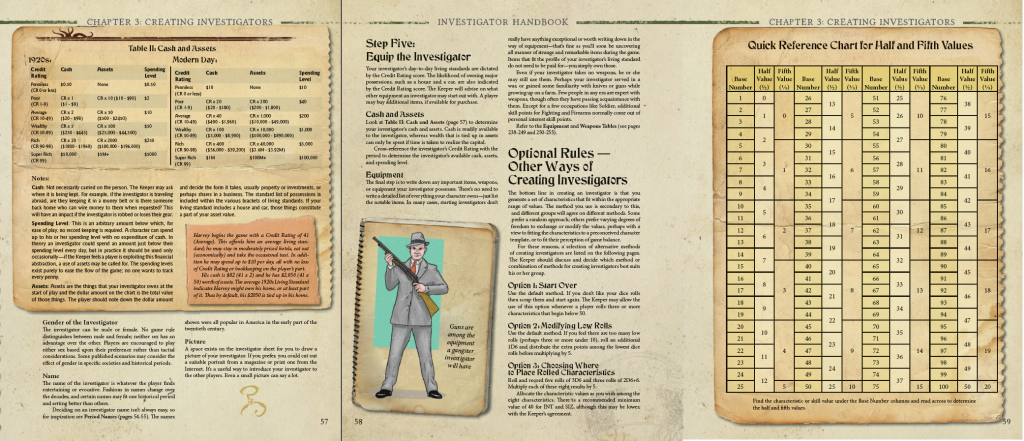Adventures in System & Adventure #1 – Call of Cthulhu
If you’ve played any number of RPGs and adventures you’ve probably had a conversation along the lines ‘Could you run Masks of Nyarlathotep in Troika?’, or ‘Would it run Keep on the Borderlands?’, or whatever. Even if you’ve played just that one RPG you’ve probably talked about using it for cowboys in space. You probably shouldn’t though. It’s like using a shoe to stir soup, you can but it isn’t worth it.
One area where these thoughts have most intrigued me is in investigative games. Established big games like Call of Cthulhu have been around the block about seven times and are recognisable faces for the RPG hobby overall. So when I acquired some Call of Cthulhu solo adventures on the cheap I wanted to see if I could run them using a system that blew my mind when I first read it, Cthulhu Dark.
If you don’t know anything about the two systems, Call of Cthulhu has been around since the 80s, been through many editions, and is crunchy and detailed like engraved cereal. Significantly, this means there is a wealth of content around for it, both old and new. Cthulhu Dark, by comparison, is relatively new, about as light as a dice-based system can be, and I daresay deliberately nothing like Call of Cthulhu.
To try this out, I tried to make the same character in both games and played Call of Cthulhu’s solo adventure Alone Against the Flames through, one in each system.
I had some questions in mind to answer:
- Will the adventures be usable in the other system?
- Whether yes/no, how meaningfully does the system interact with the adventure content?
- What friction does switching systems create when running a system-specific adventure?
- Which system is more fun for these adventures?
- Do the adventures effectively sell the system?
I’m not calling this a review, and I won’t even try to defend my readings of the text. I’m recording an experience I had on a Saturday afternoon over a couple of coffees and some snacks.
Making a character
Before this, I knew Call of Cthulhu was a bit fiddly for my tastes, but I did not expect character creation to be as much as work as it was. I expected that given this is a text that’s been around since I was minus four years old it would be pretty well revised and tuned up by now.
The fiddliness of the system wasn’t an issue, it was the clarity of the text in the book and way information was presented. It was confusing in ways that had me flipping back and forth because of flawed information design, and some things were genuinely unclear. I’ll do one example of each, but they aren’t the only examples.
Confusing Text
Like many RPGs you roll your stats. A mix of 3d6 and 2d6+6 is used, and the results are all multiplied by five to give your character’s actual score. You roll your eight stats in order and write them down on a scrap of paper (not your character sheet), then you modify them for your age, and then you get into half and fifth values. It tells you what to do and tells you can now write these numbers on your character sheet. Except on the character sheet I’m using, there aren’t boxes for Half and Fifth with Luck, and the stats are in a different order to the book.

Is this a huge deal? No. Is it an annoying source of friction that would be a point of pain for someone new to RPGs? Yes. I went back and reread luck to see if it was mentioned. It wasn’t. I read the half and fith bit to see if it mentions it. It doesn’t. I checked the character sheet in the back of the book (I’m using a newer one from Chaosium’s website) and it has a track for luck rather than treating it as a characteristic. I notice luck is referred to as a score, not a characteristic, but then it is rolled at the end of the ‘Roll Characteristics’ section. Was I supposed to pick up on that wording? Honestly unsure, but (un)clearly it is handled differently.
There were a few things like this where I found myself reading and rereading to make sure I understood. Here’s a bonus spicy badboi paragraph. Perhaps try rewriting this yourself to make it clearer.

Information Design
I found several times I was flipping around for information in weird ways, or that info was broken up confusingly. To do this I need to look at a 3 page section of the rulebook and how it is arranged. Sadly, that means I can’t really alt text the image very well (tips on this welcome btw).

In the physical book, pages 58 and 59 are a spread. Page 58 tells us about choosing equipment for your investigator. As soon as I read this and it mentioned referring to a table my eyes were drawn across to the enormous table on the right. This was natural and instinctive. I know there’s a page number listed, but that’s not the point. The book said table, and the very large table announced its presence.
Thing is, it’s not the right table. The table you want is on the page before (57), which you have to turn back to. You could swap these two tables around quite easily. The page 59 table could definitely be slightly smaller. Page 57 has space taken up by visual filler. Page 58 has a splash illustration that is less important than how this information is sequenced. The table on page 59 isn’t connected to any of this information, it’s a reference of for the stats we started rolling back on page 43.
It’d be better placed next to the table about stat numbers on 47 (making it page 48). That’d push the table from 57 you need onto a spread with the page that references it. Almighty science, this is confusing. That’s the experience of referencing this info. Some of the info design feels little better than random. I’d love to understand how the table on page 59 came to be where it is. I think reading this post we can perhaps guess that layout was fairly hastily done and redone when the project was much delayed.
Back on Track
I’ve written far more about Call of Cthulhu character generation than I anticipated, and very little about my actual character as part of that. I made a character in the end, it was fine, but took me longer and was harder than I think it should have been. He’s a journalist called Sterling Dispatch. He is represented by 60-something numbers and under 100 words. That fact alone can probably inform your opinion of the two systems.
Coming to make Sterling in Cthulhu Dark took literally a minute. Admittedly I had a clear concept of him in my mind after Call of Cthulhu, but I filled out his Name, Personality, Occupation, Specialty, Flaw, Postitive and Negative Relationships and then I was done. Notably I couldn’t pick other PCs for the relationships and this was a sign of things to come. Two numbers (stating harm and sanity) and about ten words.
Playthrough #1 – Call of Cthulhu
Full disclosure, this solo adventure was intended to be used with the quickstart rules and as such it actually helps you generate your character during play. I went in with Sterling already made. Honestly thought, it was night and day. The chargen here is what I wish the core book had been, succinct, guided step by step. It being integrated with the fiction worked really well and the character develops scene by scene. Really well done. It’s basically a choose your own adventure book with some CoC dice rolls bolted on.
That continues throughout, Alone Against the Flames was fun. I read passages of it out loud to myself in my living room. I did the voices for the NPCs. I reacted to the prompts out loud (“no fucking way am I touching the bear.”). I had a good time. That said, I didn’t use Call of Cthulhu very much. I rolled the dice maybe four times? I only passed one of those rolls and my reward for doing so was to mark the skill for later advancement, as far as I can see it didn’t open up options within the story. My success in the adventure wasn’t tied to engaging with the mechanics of the game (whether this is good or bad is a question). It didn’t contain anything I would label as Lovecraftian (my reaction: oh good!).
I think as an experience and as a standalone game, it was really successful. I had a good time playing it. However, I think as a product though, it was a bit of a failure. It didn’t sell me on the Call of Cthulhu ruleset, at all. In fact it barely engaged with it apart from the character creation. It didn’t really do anything that makes it a Lovecraftian product.
It was a folk horror story in a rural village. I could happily loan this to a friend who didn’t have even the quickstart rules. They could play it, enjoy it, and be left wanting more. The thing they would want more of wouldn’t really be Call of Cthulhu though, it’d be folk horror / choose your own adventure. Given this is available in PDF for free, I saw it as a gateway product, and I don’t think it worked as that, despite me enjoying it.
Oh, Sterling Dispatch survived the scenario on first playthrough and travelled onwards to Arkham or whatever. I gather this isn’t that common.
Playthrough #2 – Cthulhu Dark
Right, let’s go again. Sitting down and reading the Cthulhu Dark rules, it is immediately apparent they will not mesh with a choose your own adventure format due to how information is gated and distributed. Call of Cthulhu works on a pass/fail basis, and the choose your own adventure text uses that distinction. Cthulu Dark always gives the information you need to move forwards to the investigator ansd imposes a level of consequence related to the roll.
This relies on a GM who has all the information and can mete it out to the players using their discretion. The choose your own adventure format means this is impossible. I did want to ditch the Call of Cthulhu mechanics though, so I went with a coin toss mechanic. Best of two for stuff Sterling is very good at, single toss for most stuff, and worst of two stuff that’s really hard. I ditched hit points and sanity as neither had been very meaningful in my playthough of Alone Against the Flames assuming I could bring them back if necessary.
In short, my second playthrough was just as good. In fact, in some ways it was better because I lay on my sofa with the book and a coin and nothing else. It was more immersive in the sense that I came out of the fiction less, there were fewer game concessions and more time spent in character. I played with a bit more reckless abandon to counterbalance some of the foreknowledge I had. I found some secrets and wound up with a very satisfying ending, albeit not one where Sterling was alive.
I didn’t miss the dice rolls, in fact the coin toss was just as good and the resolution is so immediate with no maths or checking stats. Sanity and health came up once each, and I couldn’t have died from loss of either of them if I’d tracked them. This might well because the goal of the adventure is to teach the concepts, not actually kill you with this method.
There was this time a tinge of Lovecraft in there, I met a chap who chanted some eldritch bollocks that definitely drew on ole H.P.’s ouevre for sure, but it still didn’t sell me on the mythos aspect particularly. This is closer to the Wickerman than it is anything properly Lovecraftian.
What, if anything, have I learned?
Let’s hit those questions from the beginning.
Will the adventures be usable in the other system?
Well, both no and yes. Cthulhu Dark didn’t support it due to information gating being fairly fundamentally different. Playing without Call of Cthulhu 7e rules was a piece of cake though, and I don’t actually feel the ruleset brought anything to the table. As mentioned before, I think this is great from the perspective of my own enjoyment, but a bit wobbly as a gateway product.
Whether yes/no, how meaningfully does the system interact with the adventure content?
Not very much at all. Using a coin toss instead of skills didn’t block off any content. It likely did increase my success rate a bit, but my character still died in playthrough two so I don’t think this caused a problem.
The interesting question here is around how this is clearly a starter adventure to teach the rules, so it went simple and light. I actually think that was a failure, because it didn’t sell me the game.
What friction does switching systems create when running a system-specific adventure?
Almost nothing, or absolutely everything, depending on your perspective. Playing with Cthulhu Dark was essentially impossible. Playing with a coin and dropping all of the dice mechanics was very easy. I think there’s something in here about how fundamental a mechanic is and information design is part of that. Need to mull that over some more.
Which system is more fun for these adventures?
I had just as much fun with the coin toss system I made up in thirty seconds. That didn’t necessitate owning a hardback book, buying dice, or sitting at a table. It wasn’t more fun, but I think it’s the better option in more situations for more people. Obviously if you’re explicitly using CoC for the crunch, then do so, but then this adventure likely isn’t for you as it doesn’t engage with it.
Does the adventure effectively sell the system?
Not at all. I’d happily lend this to someone who didn’t even own dice and tell them how I did the coin toss and I think they could enjoy it. Whether this matters is a really interesting question. I don’t really give a shit, but I think a company outputting adventures for a system should if their goal is to sell the system and to hook players onto a system/setting/IP.
The end, thank the stars
That was a lot longer than I expected it to be. I think if I do more of these I’ll likely split character generation and adventures into two posts.
As this blog is nascent, I’d very much like to know if this was useful, or not. Why? What systems/adventures should I do next time? Who is going to buy them for me? All importants questions.


2 Comments
Join the discussion and tell us your opinion.
Fascinating read. Look forward to more of these.
Cthulhu Dark is my favourite RPG system. I can see why it wasn’t meaningful in ‘solo mode’, though: Since it’s only real mechanic is about tension towards player death, and the end of the narrative, it’s probably not well suited to telling that kind of story.